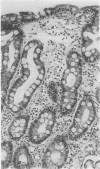Abstract
AIM: To determine associations between enterogastric bile reflux and gastric mucosal pathology. METHOD: A retrospective study using fasting gastric juice bile acid measurements and antral or prestomal biopsy specimens from 350 patients, 66 of whom had previously undergone surgery that either bypassed or disrupted the pyloric sphincter. RESULTS: Bile reflux was positively associated with reactive gastritis and negatively with Helicobacter pylori density. After stratification for previous surgery, age, and H pylori status, the histological feature most strongly associated with bile reflux was intestinal metaplasia, including all its subtypes. The prevalence of intestinal metaplasia was greatest in patients with both H pylori infection and high bile acid concentrations. Bile reflux was also positively associated with the severity of glandular atrophy, chronic inflammation, lamina propria oedema and foveolar hyperplasia. CONCLUSIONS: Bile reflux is a cause of reactive gastritis. It modifies the features of H pylori associated chronic gastritis. The changes are not confined to patients who have had surgery to their stomachs. The positive associations with atrophy and intestinal metaplasia have implications for models of gastric carcinogenesis.
Full text
PDF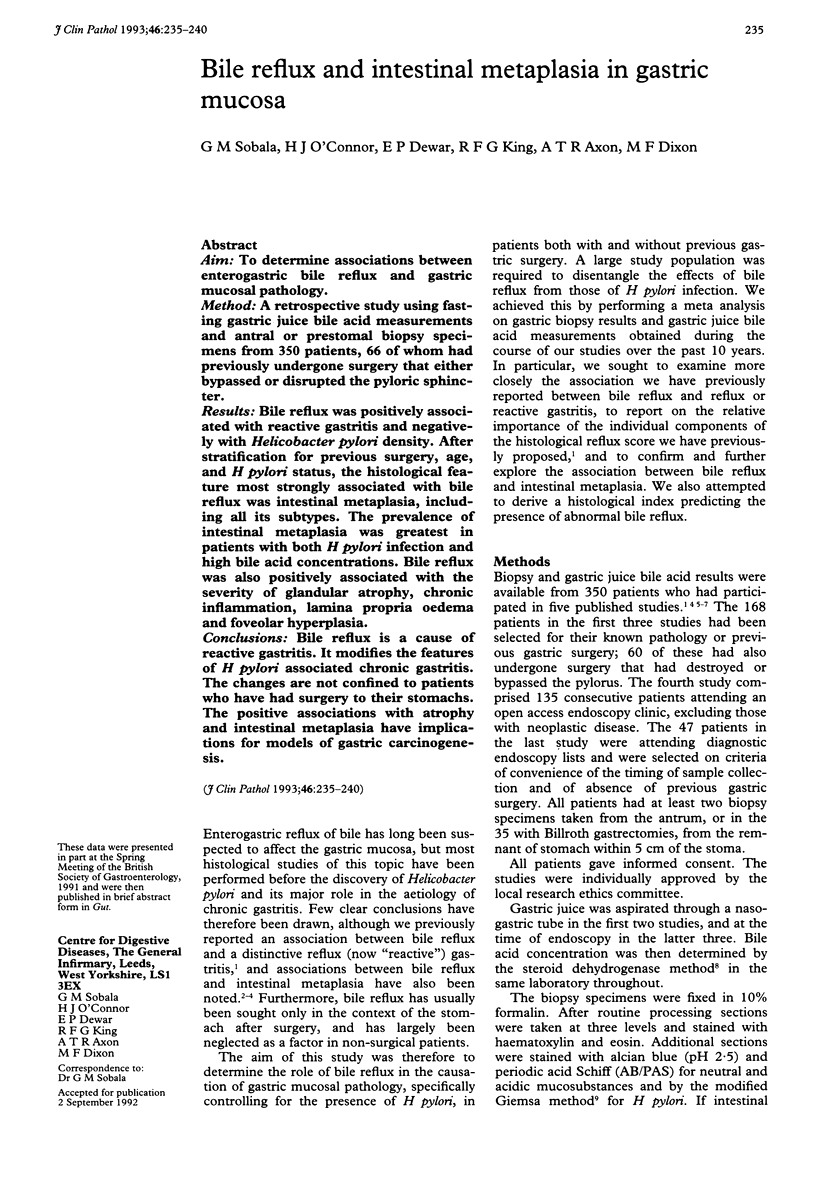
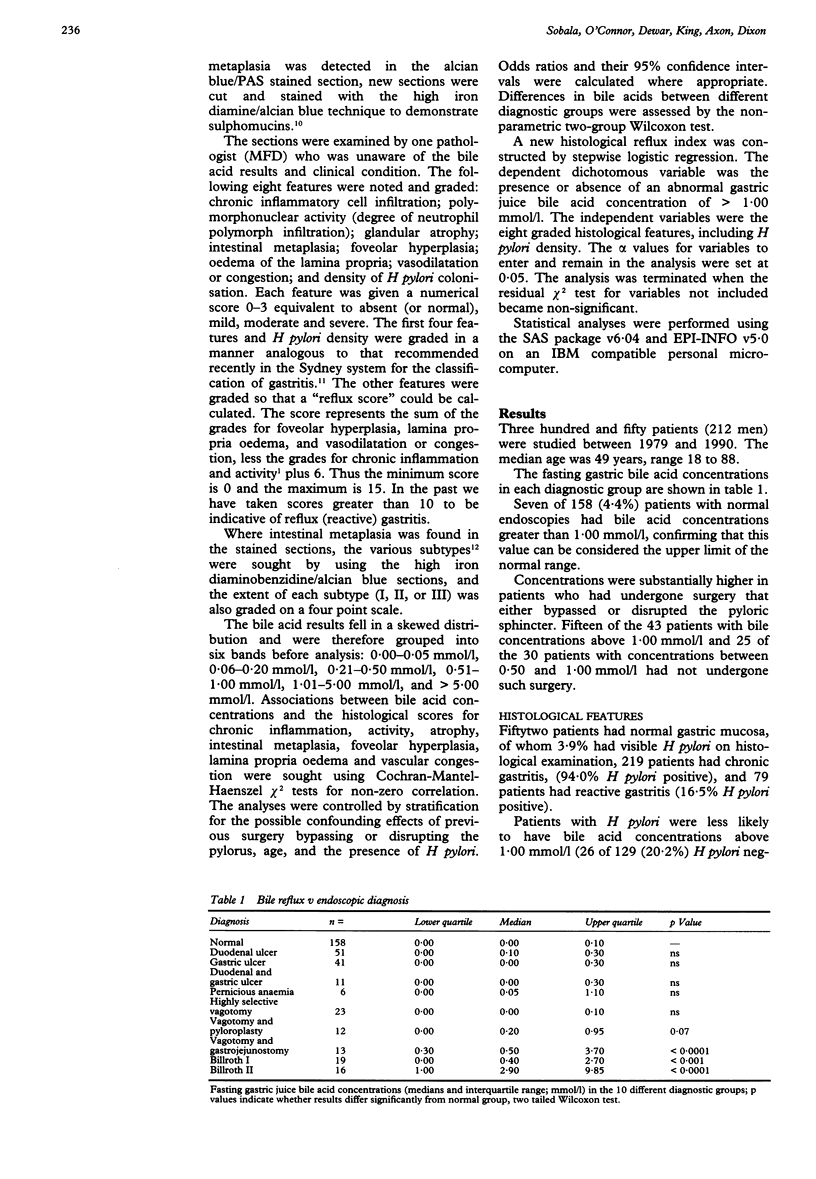
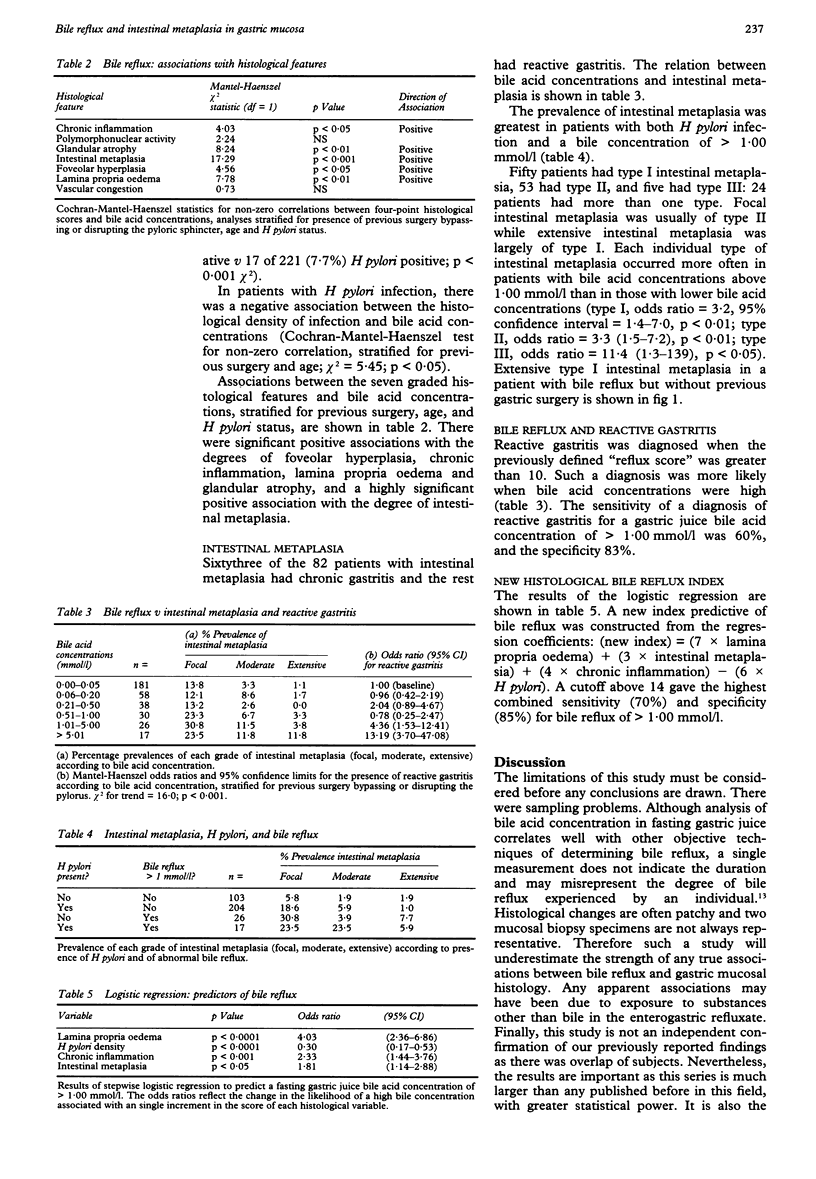
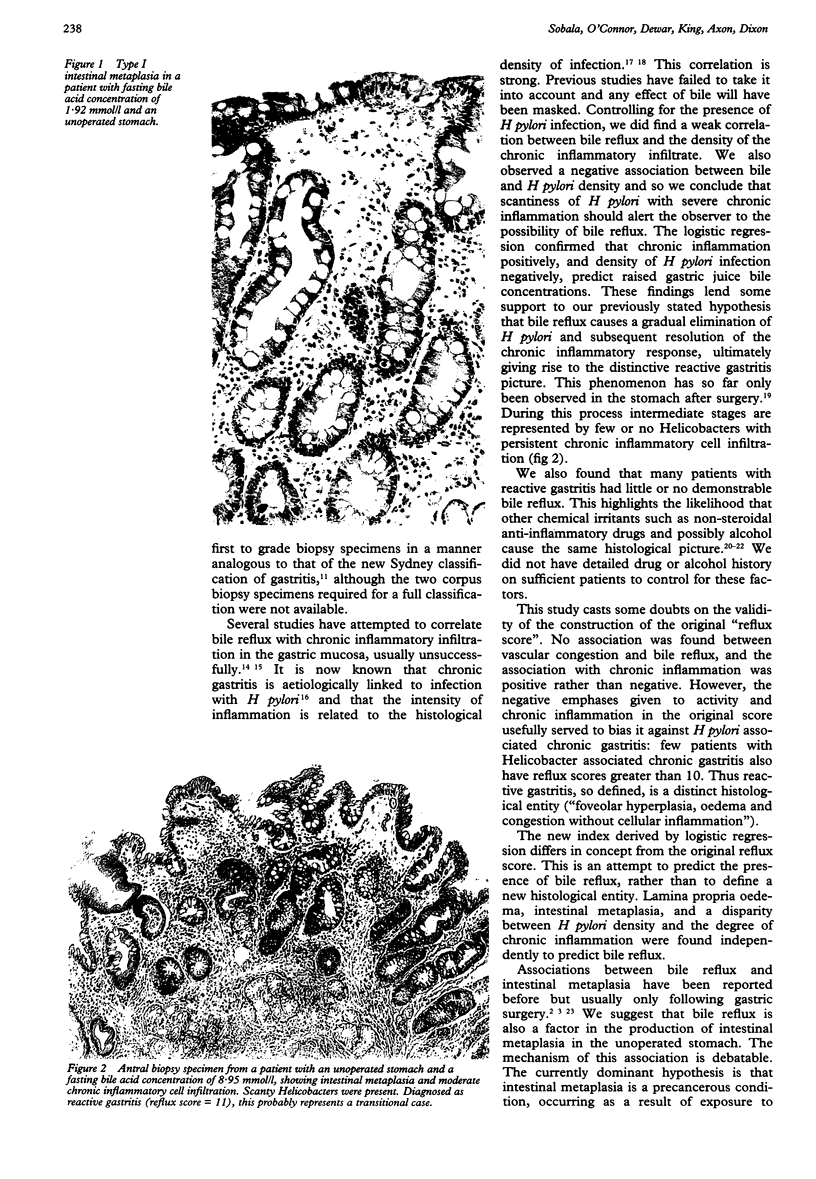
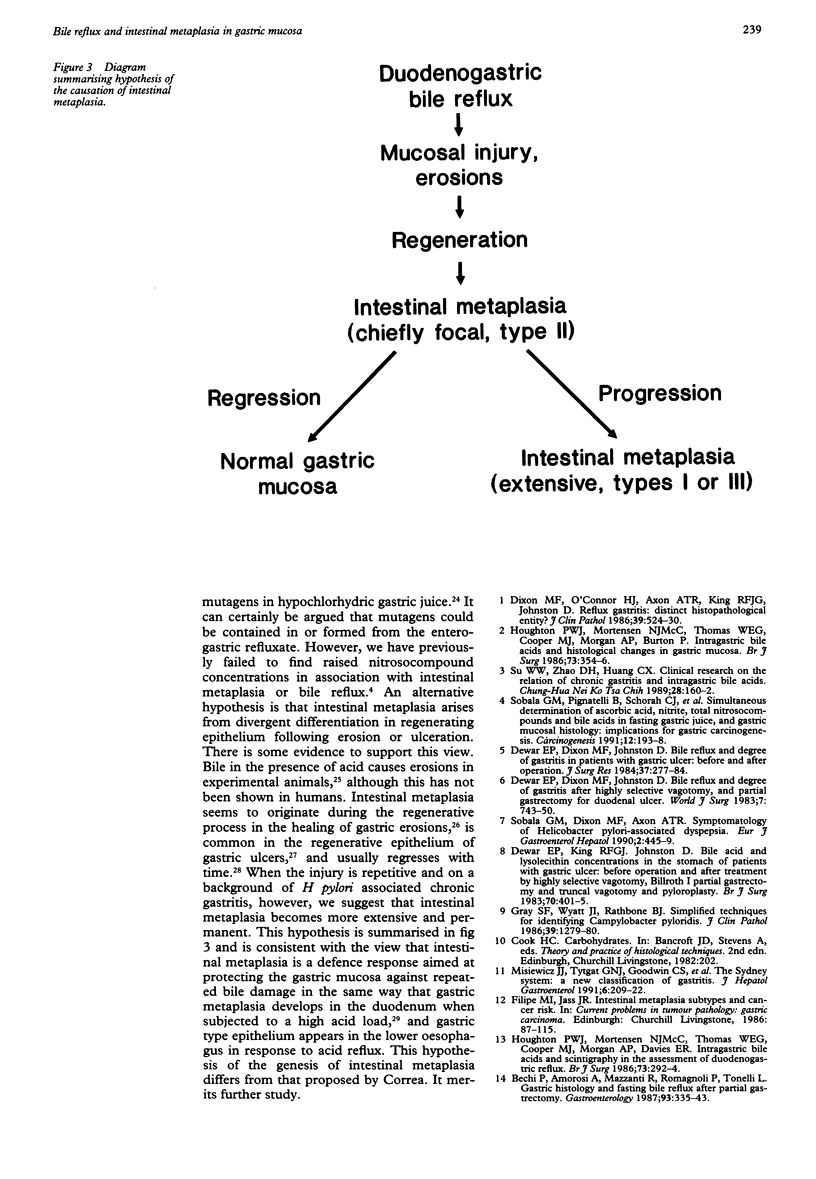
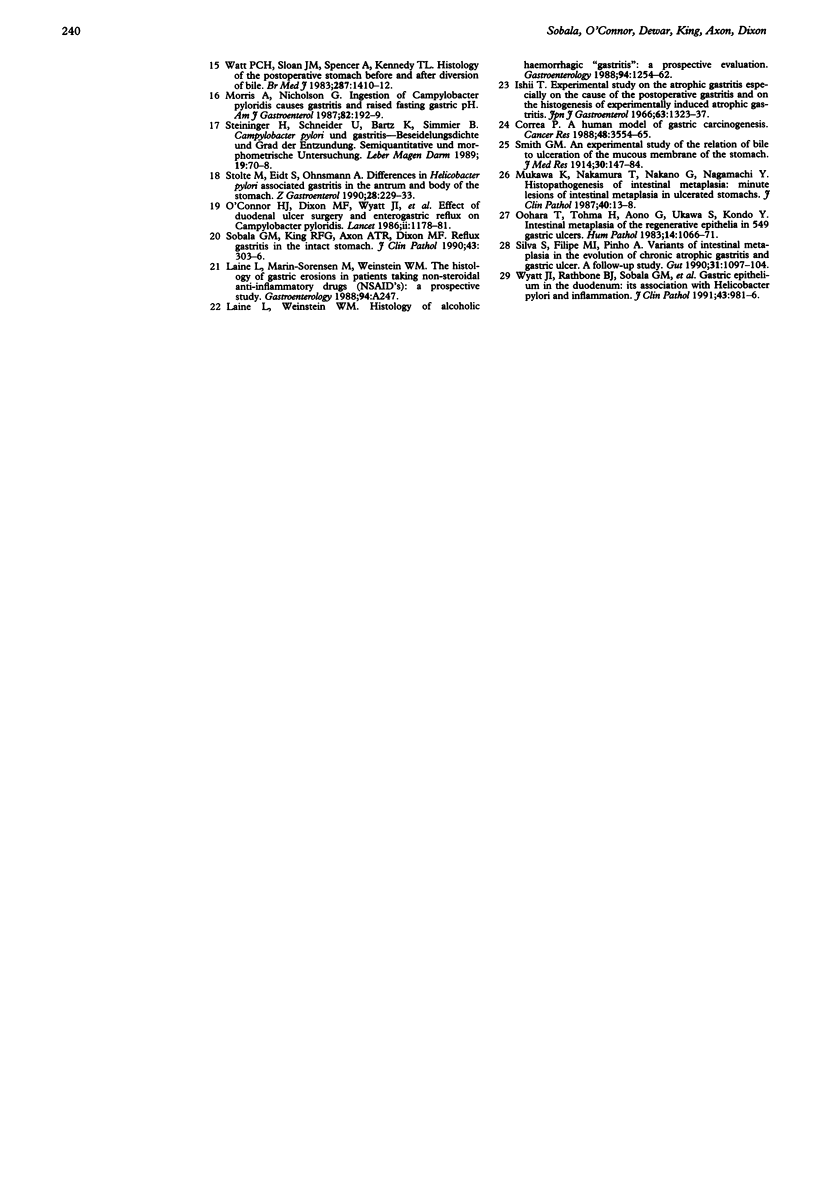
Images in this article
Selected References
These references are in PubMed. This may not be the complete list of references from this article.
- Bechi P., Amorosi A., Mazzanti R., Romagnoli P., Tonelli L. Gastric histology and fasting bile reflux after partial gastrectomy. Gastroenterology. 1987 Aug;93(2):335–343. doi: 10.1016/0016-5085(87)91024-9. [DOI] [PubMed] [Google Scholar]
- Correa P. A human model of gastric carcinogenesis. Cancer Res. 1988 Jul 1;48(13):3554–3560. [PubMed] [Google Scholar]
- Dewar P., Dixon M. F., Johnston D. Bile reflux and degree of gastritis in patients with gastric ulcer: before and after operation. J Surg Res. 1984 Oct;37(4):277–284. doi: 10.1016/0022-4804(84)90189-6. [DOI] [PubMed] [Google Scholar]
- Dixon M. F., O'Connor H. J., Axon A. T., King R. F., Johnston D. Reflux gastritis: distinct histopathological entity? J Clin Pathol. 1986 May;39(5):524–530. doi: 10.1136/jcp.39.5.524. [DOI] [PMC free article] [PubMed] [Google Scholar]
- Houghton P. W., Mortensen N. J., Thomas W. E., Cooper M. J., Morgan A. P., Davies E. R. Intragastric bile acids and scintigraphy in the assessment of duodenogastric reflux. Br J Surg. 1986 Apr;73(4):292–294. doi: 10.1002/bjs.1800730415. [DOI] [PubMed] [Google Scholar]
- Kovacs J. A., Gill V., Swan J. C., Ognibene F., Shelhamer J., Parrillo J. E., Masur H. Prospective evaluation of a monoclonal antibody in diagnosis of Pneumocystis carinii pneumonia. Lancet. 1986 Jul 5;2(8497):1–3. doi: 10.1016/s0140-6736(86)92555-9. [DOI] [PubMed] [Google Scholar]
- Laine L., Weinstein W. M. Histology of alcoholic hemorrhagic "gastritis": a prospective evaluation. Gastroenterology. 1988 Jun;94(6):1254–1262. doi: 10.1016/0016-5085(88)90661-0. [DOI] [PubMed] [Google Scholar]
- Morris A., Nicholson G. Ingestion of Campylobacter pyloridis causes gastritis and raised fasting gastric pH. Am J Gastroenterol. 1987 Mar;82(3):192–199. [PubMed] [Google Scholar]
- Mukawa K., Nakamura T., Nakano G., Nagamachi Y. Histopathogenesis of intestinal metaplasia: minute lesions of intestinal metaplasia in ulcerated stomachs. J Clin Pathol. 1987 Jan;40(1):13–18. doi: 10.1136/jcp.40.1.13. [DOI] [PMC free article] [PubMed] [Google Scholar]
- Oohara T., Tohma H., Aono G., Ukawa S., Kondo Y. Intestinal metaplasia of the regenerative epithelia in 549 gastric ulcers. Hum Pathol. 1983 Dec;14(12):1066–1071. doi: 10.1016/s0046-8177(83)80263-9. [DOI] [PubMed] [Google Scholar]
- Silva S., Filipe M. I., Pinho A. Variants of intestinal metaplasia in the evolution of chronic atrophic gastritis and gastric ulcer. A follow up study. Gut. 1990 Oct;31(10):1097–1104. doi: 10.1136/gut.31.10.1097. [DOI] [PMC free article] [PubMed] [Google Scholar]
- Sobala G. M., King R. F., Axon A. T., Dixon M. F. Reflux gastritis in the intact stomach. J Clin Pathol. 1990 Apr;43(4):303–306. doi: 10.1136/jcp.43.4.303. [DOI] [PMC free article] [PubMed] [Google Scholar]
- Sobala G. M., Pignatelli B., Schorah C. J., Bartsch H., Sanderson M., Dixon M. F., Shires S., King R. F., Axon A. T. Levels of nitrite, nitrate, N-nitroso compounds, ascorbic acid and total bile acids in gastric juice of patients with and without precancerous conditions of the stomach. Carcinogenesis. 1991 Feb;12(2):193–198. doi: 10.1093/carcin/12.2.193. [DOI] [PubMed] [Google Scholar]
- Steininger H., Schneider U., Bartz K., Simmler B. Campylobacter pylori und Gastritis-Besiedelungsdichte und Grad der Entzündung. Semiquantitative und morphometrische Untersuchung. Leber Magen Darm. 1989 Mar;19(2):70–78. [PubMed] [Google Scholar]
- Stolte M., Eidt S., Ohnsmann A. Differences in Helicobacter pylori associated gastritis in the antrum and body of the stomach. Z Gastroenterol. 1990 May;28(5):229–233. [PubMed] [Google Scholar]
- Su W. W., Zhao D. H., Huang C. X. [Clinical research on the relation of chronic gastritis and intragastric bile acids]. Zhonghua Nei Ke Za Zhi. 1989 Mar;28(3):160-2, 187. [PubMed] [Google Scholar]
- Watt P. C., Sloan J. M., Spencer A., Kennedy T. L. Histology of the postoperative stomach before and after diversion of bile. Br Med J (Clin Res Ed) 1983 Nov 12;287(6403):1410–1412. doi: 10.1136/bmj.287.6403.1410. [DOI] [PMC free article] [PubMed] [Google Scholar]
- Wyatt J. I., Rathbone B. J., Sobala G. M., Shallcross T., Heatley R. V., Axon A. T., Dixon M. F. Gastric epithelium in the duodenum: its association with Helicobacter pylori and inflammation. J Clin Pathol. 1990 Dec;43(12):981–986. doi: 10.1136/jcp.43.12.981. [DOI] [PMC free article] [PubMed] [Google Scholar]



